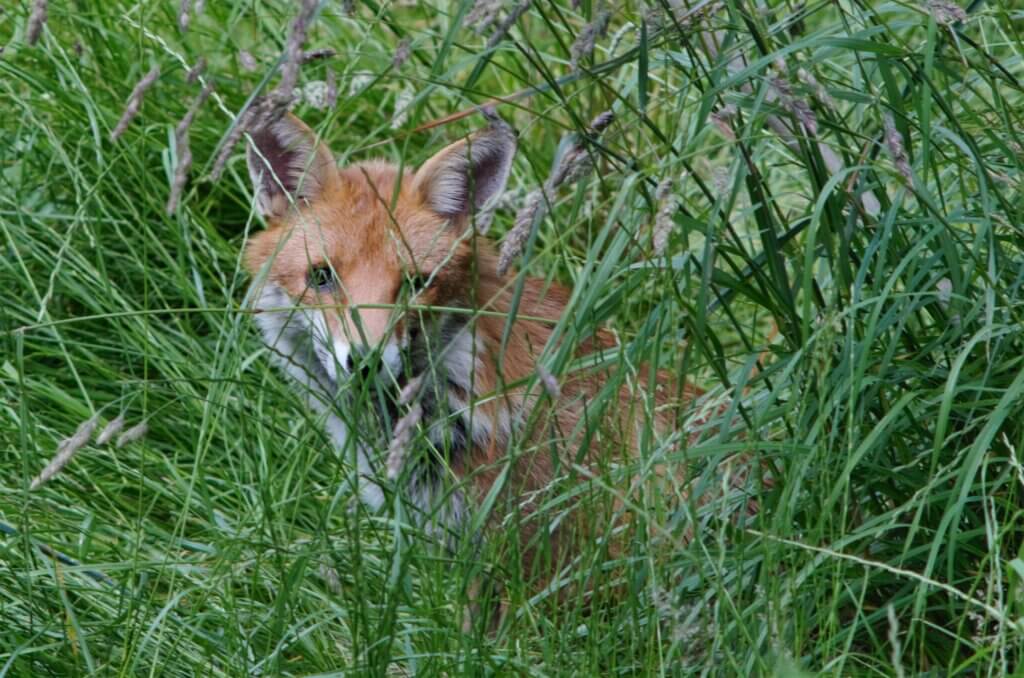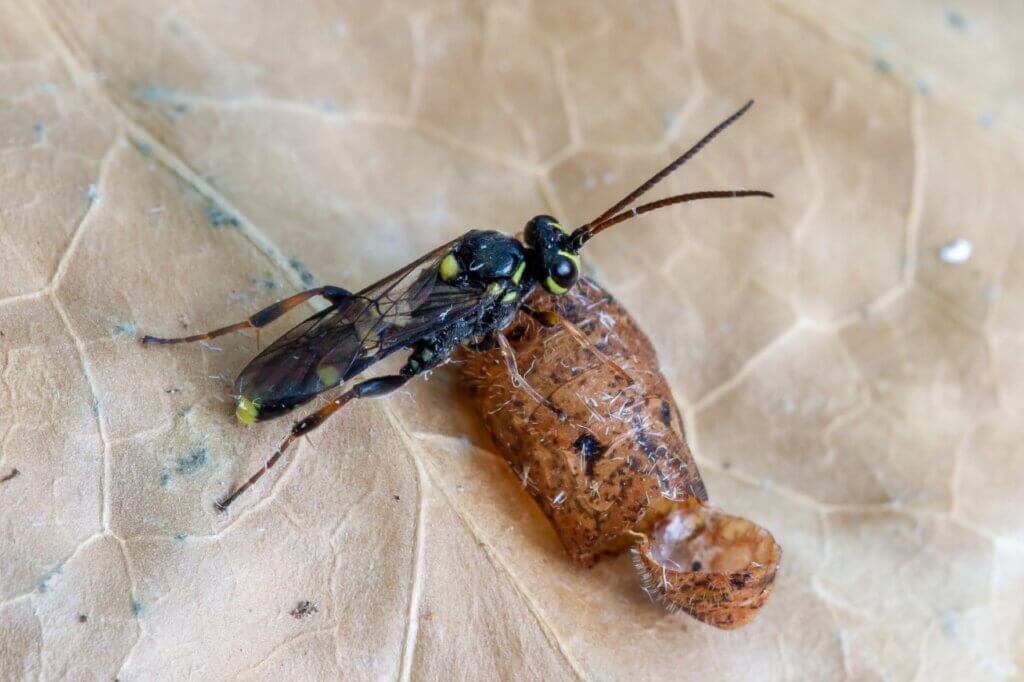
Nick Ballard’s interest in butterflies and moths evolved exploring the hedgerows and fields, streams, ditches and ponds, meadows and verges that formed the great outdoors where he lived as a child – Selby, on the river Ouse in Yorkshire. He first worked as a computer operator in Cambridge in the Computer Aided Design centre and then for many years as a consultant. He is a member of many national and local conservation organisations including Butterfly Conservation.
Spin 27 in my new calendar

As I lie on my back in the garden, not a cloud in sight only clear blue sky and freshly unfurled lime green leaves above, I think, as many people at this moment might, it is good to be alive. In fact, this period of isolation has made me look closer at everything in the garden. My mind and lens have examined a huge variety of flies, hoverflies and bugs that I might not have even thought about had times been ‘normal’. To say nothing of the butterflies that seek-out my south-facing suntrap for warmth and shelter from this ripping easterly breeze that has picked up over the last 24 hours. You can certainly feel we are only 12 miles from the North Sea as the seagull flies.
I close my eyes and listen to the birds – the robin in the garden plies his melodies around the twittering of finches and chatter of tits from the trees above, whilst a wren angrily spits out a warning, presumably because the cat has returned for lunch. I re-open my eyes and look around. A Brimstone drifts by, immediately accosted by a male Small White that rises from the ivy covering the fence to briefly check for a mate or spoil for a fight, if the need arises. Three male Holly Blue spiral above, seeking dominance in the mating stakes as a female hunkers down below, awaiting the outcome. Such is the luxury of time most of us have now, though I appreciate just how lucky I am to have a garden.

I use that term loosely, since I stopped cutting the grass when I observed Speckled Wood egg-laying and a fox came to take in the sun as the grass grew longer. I imagine what might have happened if I had taken the advice given and stripped the Ivy from the15 metres of my boundary fence? The RHS states, ‘More than 140 species of insect and 17 species of bird feed on ivy in Britain, and countless others appreciate its evergreen shelter’, so it is a massive bonus for wildlife to have ivy in a garden. That is why I value, more than anything else in my garden, that ivy-covered fence; it opens-up the possibilities for wildlife massively. It is a shame that many other gardeners do not see it that way.

One insect I would certainly miss, not the Brimstone that hibernate overwinter in the ivy, nor the Holly Blue that emerge from their pupae in Spring, is Listrodomus nycthemerus, an Ichneumon wasp. Without that ivy we would certainly not have this magnificent creature, even if it does have a rather grisly lifecycle, if you are a Holly Blue butterfly, that is.

My interest in these wasps was sparked by the moth and butterfly caterpillars I kept as a kid. Caterpillars sprouted silky small cocoons, pupae revealed large and small evil-looking wasps and flies, instead of the expected beautiful results. Nature had no compassion, just a compelling desire to reproduce by whatever means possible it seemed. So the poor Holly Blue is haunted by the presence of this wasp, which lays its eggs solely in the larvae of this species, whose summer generation larvae use ivy. No Ivy = no Holly Blue = no L. nycthemerus. It would truly be a poorer world should this ever happen; so next time you see some ivy, have a thought before you leave it…

The prejudice against ivy is appalling. This folk tale that it kills trees etc. How on earth did it get to firmly rooted? We need to fight it at every opportunity. It’s like the prejudice against ragweed.
I totally agree – we have loads of it and once it flowers it’s covered with insects.
It also looks lovely, as Mark’s photo shows.
Thanks also to CC for good idea about inter-planting with a clematis.
We have a brick wall at the end of our back garden and it is totally covered by Hedera hibernica. I have noticed unfortunately that the flowers seem to have set fewer fruit in the last few years. It is rare to see a full bunch of ivy berries. Was this due to unfavourable weather conditions at the critical time of pollination, or could it be a reflection of reduced insect numbers?
If you want ivy in your garden and don’t have a suitable wall or robust fence, you can make an ivy pole using an 8 ft fence post fitted into a metal shoe just driven into the soil, keeping the post above soil level. Hammer in two nails into opposite sides at intervals up the post and create loose loops with garden wire. This allows the ivy stems plenty of space to become trunk like eventually. Plant your ivy of choice at the base and feed the stems under the wires as it grows until it reaches the top and then let it do its own thing. It will then grow back down and out. A mild mannered clematis can be added to the mix for further ornamentation if desired. Any ivy pruning if it becomes necessary should be done before February. The clematis can be pulled out and snipped off for it to start up again in spring. We have a robin nesting in ours at the moment.
Brilliant idea, you could use an awful lot of recycled materials, would honeysuckle work as well as a companion plant, Scotland’s a bit chilly for clematis maybe? To repeat a suggestion made a few weeks ago appropriate walls in urban areas could have a message such as ‘IVY PROTECTS WALLS FROM FROST DAMAGE, REMOVES AIR PARTICLES AND IS GREAT FOR WILDLIFE’ stencilled on and then ivy planted at the base. By the time the stencil is obscured hopefully anti ivy ignorance will have dissipated.
We have plenty of Ivy around our garden and small holding. Its a wonderful plant for wildlife throughout the year, even now when there are undoubtedly birds nesting in it the Wood Pigeons are still visiting to eat the berries. We also have Holly Blue Butterflies, later when the Ivy flowers its covered in bees and hoverflies with Red Admirals amongst them. A great plant.
The ivy –> butterfly –> wasp trail is exactly the wildlife tale that we need to tell to get people thinking in a more balanced way about nature.
How many gardeners would be happy to see a mouse in their garden stealing bird feed? Would that change if they knew that the mouse holes were vital in providing bumblebees with places to nest?
Max – would love to have mice; I certainly do have rats. Do they have a similar role in bumblebee nesting?
There was a very good article on that relationship in British Wildlife a few years ago. About how the numbers of Holly Blue rise year by year, then the parasite catches up and the HB numbers crash, followed by the parasite numbers, and so on. A classic ecological relationship!